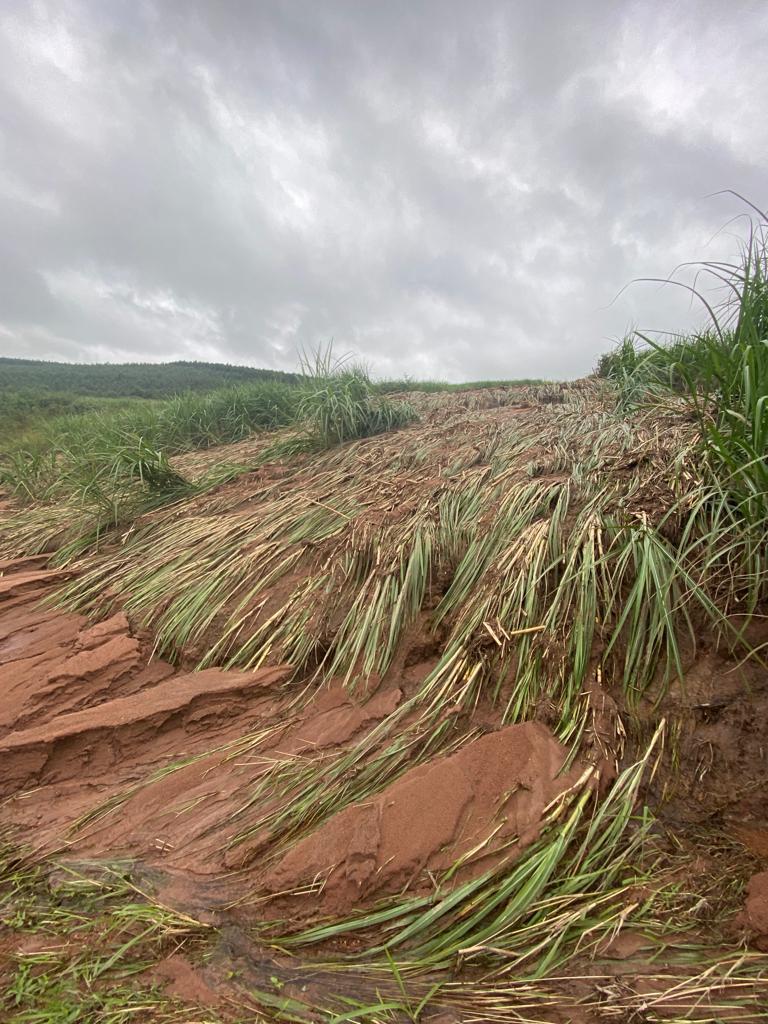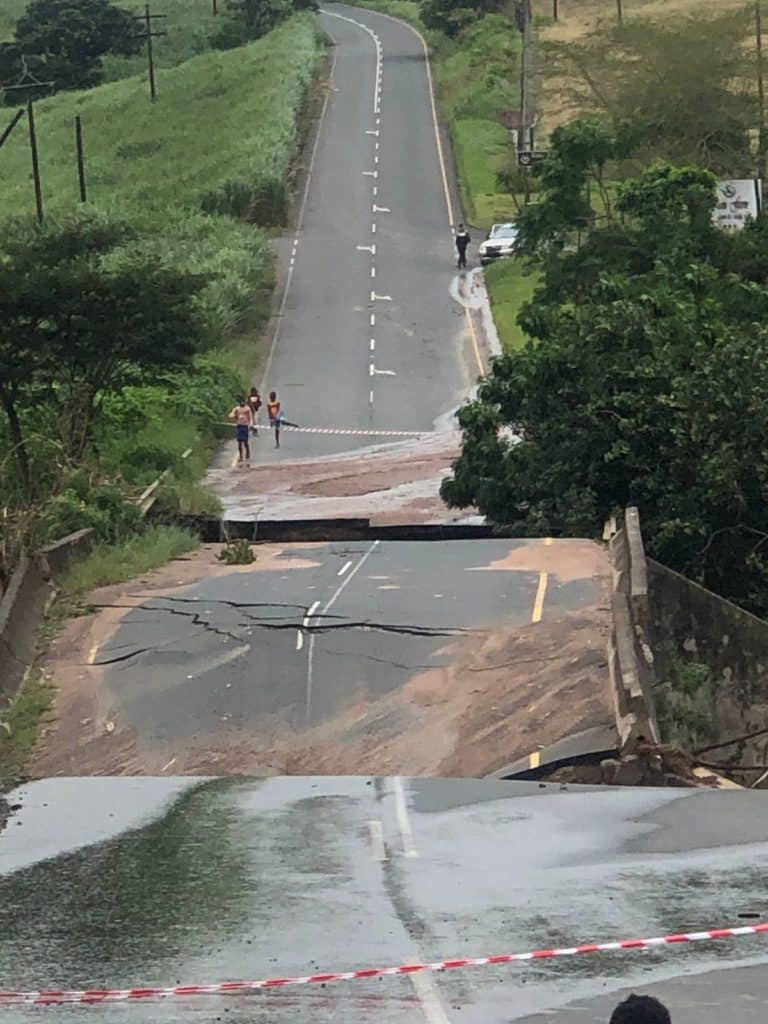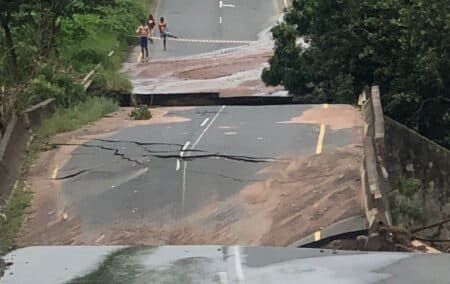‘Natuurramp is erger as menseramp.’ A natural disaster is worse than a human disaster. I remember these words from a news show prior to the 1994 election, a segment of which was looking at survivalists stockpiling food and supplies for the apocalypse that was scheduled for 27 April.
Natural forces do not lend themselves to negotiation or restraint or pity. They do what they do until their momentum runs out – and will do whatever damage is to be done before that happens.
KwaZulu-Natal over the past few weeks has shown just how destructive nature can be. An official presentation to the Inter-Ministerial Committee dealing with the situation – dated 19 April – put it in bland officialese: ‘As from 08-13 April 2022, KZN Province experienced prolonged heavy rainfall incidents which resulted in flooding, mudslides, structural collapse in coastal areas of the Province.’
The damage inflicted by the rains is still being assessed. In financial terms, official estimates last week put this at R12.7bn, encompassing damage to be addressed by sector departments – that is, say, clinics managed by the Department of Health, support for housing through the Department of Human Settlements and so on – and that suffered by individual municipalities. Much of this information was incomplete and a revised global figure in the order of R17bn is now doing the rounds. This figure accounts for additional assets, such as the rail network, which lost some 300 km of track.
Some 435 people are (at this writing) recorded to have died in the flooding, with several dozen still missing.
Expect both the costs of the damage and the death toll to move up in the coming days.
One group that has few illusions about the vagaries of nature and the risks that it can pose is the province’s farmers. Farming is a hard business, and the gentle pastoral idyll of life on the land is more likely to exist in the imagination of those with no experience of it than of those who do.
The Daily Friend reached out to a number of farmers and agricultural stakeholders to get a sense of their experiences, and to probe what we can learn from this disaster.
Stunned
What was striking was that even people well-accustomed to dealing with the force of nature were stunned at what has just taken place.
One obvious historical point of reference was the flooding that occurred in the region in 1984 and 1987, with in some respects similarly catastrophic consequences. As a precaution against a recurrence, infrastructure such as pumping stations was sited well out of reach of any possible floodwaters. This time, even heightened elevation didn’t save them from being overwhelmed by the flood.
Dave Wise, who farms macadamia nuts, litchis and sugar cane near Ballito, said that what differentiates this disaster from previous flooding was that not only did the rivers break their banks, but the rainfall was at a level not seen before. It was just ‘a huge amount of water concentrated. This is so even though the river system [the Umhlali] is well maintained.’ He explained to The Daily Friend how the sandy soil could only absorb so much water. It saturates, creating what he called a ‘milkshake’ effect. The ground became unstable and gravity took over; landslides just pulled soil down hillsides.

A similar account was given by others. Roger de Billot, a sugar cane farmer in the Eston area and chairman of the local farmers’ association, described the flooding as worse than previous events, sweeping away tracts of land and wrecking roads and bridges, both farm and public infrastructure.

And Ant Goble, who farms sugar cane, bananas and macadamia nuts in the Upper Tongaat area, comments succinctly: ‘The floods hurt us badly.’
Sandy La Marque, CEO of the KwaZulu-Natal Agricultural Union (Kwanalu), expressed scepticism about the official estimates of damage suffered by the farming economy. Last week, this stood at some R63.4m (including crops, livestock and infrastructure, as recorded under the Agriculture ‘sector department’). But an early survey of farmers by Kwanalu put the costs of damage to roads on farms at R87m, and to bridges at R34m. Even these numbers are only partial estimates (as things stood on Monday), and will inevitably climb higher.
Preliminary estimate
Indeed, the South African Canegrowers Association has issued a preliminary estimate of the scale of damage, putting it at just under R223m.
Agricultural economist Wandile Sihlobo told the Daily Friend: ‘It will be a while before we have a total extent of damage, as we don’t even have a total tally of human loss.’
Even large sums of money do not capture the full extent of what has happened. Floodwaters can destroy years of investment, particularly in plants that require extended periods before they are able to yield crops. Macadamia trees, for example, can be expected to produce after three to four years, but only after about a decade will the investment break even. Dave Wise’s farm of 280ha lost orchards totalling some 30ha. The loss of trees effectively sets this part of the farming operation back to the start. Trees were literally washed away.
There is no easy recovery when not only the asset but its years of cultivation are destroyed. In such cases, even a generous insurance settlement – where this might be forthcoming, since insurance is taken for foreseeable events, which for many flooding of this nature did not seem to be – will never provide adequate compensation.
In addition, there are the knock-on effects. Sandy La Marque points out that destruction of fencing creates grave biosecurity risks. KwaZulu-Natal has suffered outbreaks of foot and mouth disease in the past year, something that comes near the top of livestock farmers’ concerns. (The Daily Maverick carried an article about the outbreak as recently as 24 March this year.) So, expect the cost of flood-induced damage to grind on too…
Roger de Billot and his brother Paul, also a sugar cane farmer in the Eston area, said that for their industry, the floods came on top of an already difficult time for the sugar industry. Because of capacity constraints at sugar mills, around 25% of the Eston crop could not be taken for processing – this itself represented a major blow to the farming community. The floods not only destroyed crops, but soaked the soil, making it necessary now to carry the remaining harvest out by hand.
Out of action
Ant Goble told the Daily Friend that flooding at the Gledhow Mill in Stanger has put it out of action. Machinery needs to be repaired, which could mean weeks going by before production resumes. This implies a significant loss of income, and negative implications for farm employees. More than this, over half the production at the mill comes from small-scale farmers, many of whom are land reform beneficiaries whose operations are especially vulnerable to this sort of dislocation. ‘It’s the long-term consequences…’ Goble says.
Ultimately, though, the outcome of this disaster is likely to be measured by whether any lessons have been learned from it. Sandy La Marque expresses frustration at past experience, where the focus has been on paying out some compensation, but little more. If nothing else, the floods foregrounded the importance of infrastructure to the economy of the province, and the very viability of agriculture. The floods also draw attention to the enormous deficiencies in this regard.
La Marque cites a lack of maintenance of roads and the congestion of waterways by invasive species as factors that increased the vulnerability of the province and its farmers. ‘Who knows what the impact would have been if those plants had been cleared, and water allowed to flow?’ she asked. These failings need to be corrected as a matter of urgency.
The De Billot brothers also point to the condition of district roads as a long-standing problem, with very little maintenance leaving them vulnerable to a disaster of this nature. The damage done by the floods made many of them impassable, making it all the more difficult to get cane to the mills – all of which impacts on the viability of farming operations. Farmers and businesses have had to step in to repair the roads to keep the cane moving. Says Paul de Billot: ‘The district roads are being repaired privately, that’s what we have to do.’
Ant Goble also expressed concerns about the impact of the damage on bridges and roads. The collapse of a bridge on the P103 cut a crucial route for the transport of cane to the Gledhow Mill.

Alternative routes had to be found, at additional cost in terms of fuel (already a rising expense) as well as wear and tear on vehicles. These costs could, he said, take years to recoup.
Tackling the damage
Currently, he says that there are moves by farmers and businesses to build a low-level bridge to replace the collapsed one. He remarks that attempts to engage the authorities about repairs have been frustrated by the fact that different agencies and tiers of government are responsible for particular assets, and they need to go through their own processes before tackling the damage. This means that even where private interests are willing to undertake repairs, they may be prohibited from doing so.
Sihlobo concurs on the centrality of infrastructure to the recovery, to farming and to future preparedness. Among the prime challenges ahead will be ensuring that infrastructure is kept functional, with due regard for the importance it plays in the life of the agricultural economy, and for the stress imposed on it by our climate.
‘As the efforts to rebuild KZN begin, the challenge of poor infrastructure is a national one and should be widened that way, especially for network industries – roads, rail, water, electricity and connectivity. We also need to keep promoting better farming methods to cope with the changing climate, and also explore the available technological solutions.’
The weaknesses of South Africa’s infrastructure have been a chronic concern for the agricultural sector for decades. They have also been acknowledged (though too often nominally, rather than substantively) by the government. In reality, we have seen insufficient new investment, a preference for big-ticket, high-profile stuff over the pedestrian business of keeping what exists functional. There is also the general predation that infects so much of South Africa’s spending.
We have seen, once again, the outcomes of this. The prospect of climate change-induced disasters made this risk more serious. This is officially acknowledged, although whether it will be acted on is another matter.
‘But now this’
Says Dave Wise: ‘Farmers are exposed to the elements and to political uncertainty. I’m always positive about things. But now this… This is where you go “whew!” Is this over, or is this something we can expect in future?’
‘We’ll be okay,’ says Roger de Billot, expressing a resilience that is so fundamental to farming in South Africa. ‘We take punches as farmers. We don’t give up. We keep going.’
‘Natuurramp is erger as menseramp.’ This may well be true, but human decisions can amplify or reduce the consequences of a natural disaster. Bad policy and poor preparation render a population especially vulnerable. And few know this better than our farmers.
[Image: Ant Goble]
If you like what you have just read, support the Daily Friend

